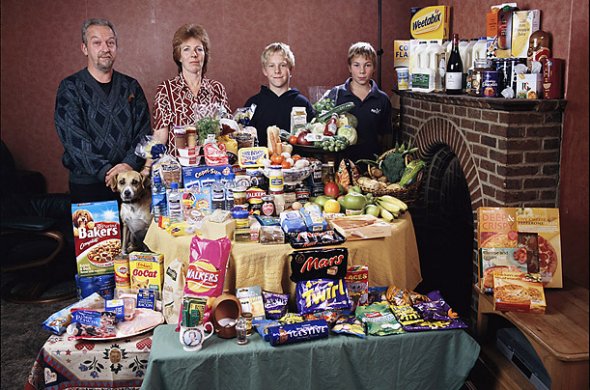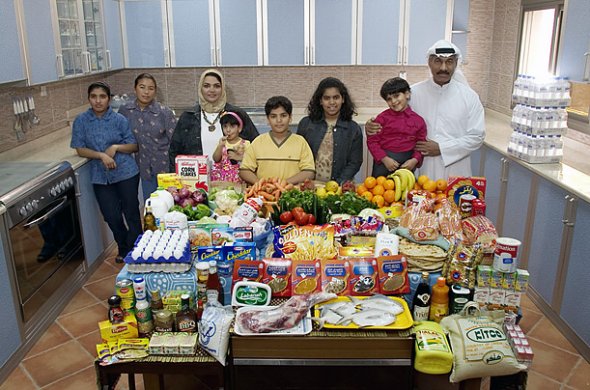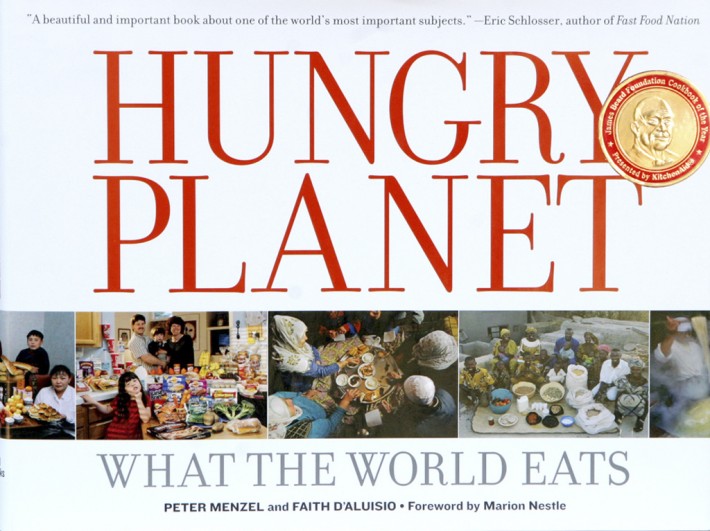It seems as a people, we have a fascination with photographing our food. From Henry's series of riders, to looking on instagram we cant help but document what we consume. Photographer Peter Menzel started this intriguing series of one weeks of groceries from around the world, taking traditional food photography to a much larger scale. In his book Hungry Planet, Peter explores both the cultural differences of diets around the world as well investigating how prosperity and poverty influence the diets of different nations.
Here is the book description of Menzel's amazing project:
The age-old practice of sitting down to a family meal is undergoing unprecedented change as rising world affluence and trade, along with the spread of global food conglomerates, transform eating habits worldwide. HUNGRY PLANET profiles 30 families from around the world--including Bosnia, Chad, Egypt, Greenland, Japan, the United States, and France--and offers detailed descriptions of weekly food purchases; photographs of the families at home, at market, and in their communities; and a portrait of each family surrounded by a week's worth of groceries. Featuring photo-essays on international street food, meat markets, fast food, and cookery, this captivating chronicle offers a riveting look at what the world really eats.

Mexico

Great Britain

USA

Australia

Germany

Italy

Canada

France

Japan

China

Poland

Kuwait

Mongolia

Turkey

View the entire series Here in Menzel's Book Hungry Planet.
If you're passionate about taking your photography to the next level but aren't sure where to dive in, check out the Well-Rounded Photographer tutorial where you can learn eight different genres of photography in one place. If you purchase it now, or any of our other tutorials, you can save a 15% by using "ARTICLE" at checkout.








Because fast food is CHEAP in the US, that's why. 15 years ago, it cost $9 (US) for a happy meal, in France. It's not cheap and easy elsewhere, only fast.
That cat from the France photo... are you sure it doesn't belong in the China picture?
I think it would have been interesting to do more developing or third world countries. We lived with an Indonesian family for a month and a week of food for them would be 10 kilos (yes, TEN!) of rice, 35 eggs, a handful of hot peppers, shallots, and garlic, and a couple heads of broccoli. Granted they were from the suburbs of the city, but they represent the larger majority of Indonesians. After living around the world and seeing how a lot of different people live, this definitely captures the middle or upper class of each country.
One thing that really stood out to me the most with the pictures of Mali & Chad being the most disturbing... note the ratio of food to the size of the family or the number of mouths to feed in each picture. And the drinks, that one clean bottle of water in the picture for Chad... clean water - something most of us take compeltely for granted.
Such a difference, especially in Chad. If we stopped living in such excess, perhaps those in Chad could benefit more?
Interesting that the US family seems to have the least amount of fresh produce and some fast food mixed in.
As an American comparing what I eat to the American family listed I'm feeling pretty good about myself. I eat lots of frozen vegetables and frozen meat, but not the preservative packed kind. Throw in some mineral water, corn chips and salsa and maybe one fast food meal a week and I'm covered.
"Could have" been done differently. Not "could of." Just sayin'.
I'm surprised more people haven't noticed this.
Wish you would have credited the book these are all in! What the World Eats gives more context to these photos (including prices!) It also shows multiple families for larger countries. Plus, it has even more photos.
Interesting, but hardly representative. There are hundreds of places around the world where a bowl of rice, or less, would be a week's groceries. Focus on the starvation level living standards of the poor, and not on the luxuries of the better off.
Could HAVE been done differently. (cringe)
Makes me great full for what I have.
http://elitenetworkmarketingguru.com/
this shows well off families and their groceries? how about those on low incomes or no incomes
This is stupid because it's selective in the fact that some of the countries I see represented here are NOT showing a typical family's week of groceries. Very biased.
The more we have the less healthy we get, is the message I'm getting from this. The variety of foods here in the U.S. are immense and economics play a bigger role in what foods a family will buy. I don't believe one example is the best way to portray any country. I would like to see pictures of groceries from varying regions of each country with families of varying financial statuses.
Before you complain about the bad nutrition habits in the US, I think we should all think of Chad first. There is some inspiration for all Americans to cut the junk and help those guys!
hey how about connecting the food with the level of happiness on the faces thats interesting too!
The answer to that is that pizza really does make you happy.
Damn! Look at Chad! I'm trying to compare the size of the people with the food consumed. The U.S. seems fittest despite eating a lot of junk.
I think that the pic for America is very accurate, and discusting. This is what they have came to, processed foods full of dyes, chemicals, and crap. The kids in the US won't hardly touch vegetables and it's alarming. What produce Americans buy is pumped so full of growth chemicals that they wonder why our cancer rate is through the roof. Drug companies love the US and love to keep us sick. In Switzerland everyone pretty much has a garden in their back yard, neighbors trade produce.. Just imagine never having to buy produce and it is 100% organic.
If I could move my children and myself out of the US I would in a minute. They are worried about terrorism, ha our own citizens are killing us through their labs.
There's no need to move. We moved to Sweden a few years ago and we have the same diet here as we did in the states but it now costs twice as much. Much of the food, especially the 'tropical' stuff come from the same places and companies (Dole, Chiquita, etc). There was also an article that came out a week or so ago about salmon from the Baltic sea being contaminated with dioxiin while another warned about hepatitis in the frozen berries. We normally eat both of those things. :-( The grass isn't always greener.
To answer the question asked by the author, I would have used reality based photographs and I wouldn't have tried to be as biased as the photographer was. It seems that the family in the USA would have to spend at least 22 to 23 hours a day either doing hard labor or in a gym to use the calories shown and not weigh in at 350 lbs each. As an American my weekly food doesn't contain any bread, HFCS, Soda, Beer, or processed food. It has about 3 pounds of meat (all from humane sources, free range and grass fed), no Dairy and no Fast Foods. Just as everyone in Chad doesn't eat like the depicted family, all Americans don't eat like the family depicted either.
Conclusion: Developed countries eat way too much. Undeveloped eat too little
One thought on interpretation: it's mentioned in the intro here that "how much" food there is doesn't vary too much from photo to photo, with a couple exceptions. True, but did you count how many people were going to share the food in each case?
One of the most interesting things to me about the series is the differences in family size and makeup, including the number of generations living together.
Um, my weekly groceries look nothing like how the US's groceries were depicted.
I am from Canada and the groceries my family has for 1 week is very different from the photo. We have a low income. We eat mostly fresh fruit and veggies. Meat only 2x a week. We eat very little prepackaged foods as they are so unhealthy and so expensive. We also grow our own food in a family member's yard as well. The USA is the most sickening of them all. Chad's is quite sad to see. People need to eat the nutrients and calories they need instead of the usual binge diets people are on now a days. Its better for your health AND your wallet.
Where's North Korea's weekly shopping? Oh that's right they don't have food in N.K I forgot!
would be helpful if the families photographed had the same number of family members of around the same age (small children certainly eat less than two teenagers).
German diets apparently come with an extra side of disdain.
That comes with barking orders at the food battalions. How else do you think they got them lined up in formation so perfectly?
Actually, many Germans tend to have a very subtle smile. I am German myself, so I can tell you that the parents are definitely smiling. The older kid is being a teenager it seems, and I guess the little kid doesn't really know how to react yet.
Outside the house you might see them smile a bigger smile, but at home it tends to be more subtle, though just as true.
It is also on the well being of the family & parts of the country. Case in point is India, where I know the family shown is from well to do family. But there are parts in India like Orissa, where you have a situation close to Chad.
This is great! A fan of my blog sent me this link as she knows I host The Grocery Game Challenge on my blog each week which includes fans who participate from the Canada, USA and Guatemala at the moment. I'm hoping to reach out to others around the world who want to share what happens in their grocery budget and in their kitchens. The Grocery Game Challenge is essentially helping fans stick to their grocery budget and to learn from each other no matter where they live in the world. I often day, debt is debt, money is money and now, food is food! Each culture brings a unique combination of foods and use them in a variety of meals. It's interesting to read about what others eat and see the weekly cost breakdown for where they live. Thanks for sharing this and putting it together! Phenomenal!
How were the families chosen? It's hard to know how representative they are of their countries. I'm from the US, and my diet hardly resembles the one in that picture.
eww - I think they picked a really unhealthy family to represent the USA, The kids I nanny for and my own family eat more like the Germans.
Where's Scandinavia uh?
You asked us to comment on how the photos were done. I think most of the items in the photos are well laid out (didn't care for the photos that had items placed so far back you couldn't even discern what they *might* be), but I did like seeing the groupings of similar items rather than a mish-mash of scattered goods. It would be highly interesting to have a written list of all of the actual items. (and perhaps wether those items fall under the category of processed, semi-processed or raw/fresh; and maybe other statistical data about the selection of items) Also, there is a varying number of people in each photo, so its interesting to compare say, Bhutan (with 13 people total) to Mali (with 15 people total) Or, the amount of food that feeds a family of 4 in, say Germany, to a family of 6 in Turkey. One could illustrate points like this in diptych presentation style (or triptych).
When I see the bags of grain, I'm curious if it's used alone (like steamed rice) or ground and made into something else (bread, soup....etc...) and how do I compare that with the breads in other photos? Since it's too difficult to document all possible socio-economic groups, it would have been helpful to have an income scale (I realize this can't be calculated in some regions) for each family that tells us what socio-economic level they are at in their respective geographic locations.
But, purely from a photographic standpoint, I think they are (mostly) composed well, they are interesting to look at and a VERY interesting topic, to say the least! The photos surely make me stop and consider my own family's choices and options. I'd like to see a project like this go further by delving into the statistical data breakdowns of the information that could be collected.
(nutritional data, etc...)
My overall reaction---difficulty imagining living where I couldn't have a good amount of fresh produce every week; even if it's just seasonal.
I need Italian, Turkish, and Guatemalan families to invite me over for dinner. Their healthy spreads look so much more appealing! I think I got healthier just looking at those pictures.
Hmmm...one or two of these is not like the other. Cool project but the comparisons are off. It looks like the photographer took a sample of folks from the middle class based on the photos. Including groceries from rural Africa (in particular) doesn't fit with the overall project. As someone from a middle class African household who lives in the city, you probably wouldn't see me sitting on the floor with a bag of a few grains...
I can't get over how in the Mexican photo, the beverages that aren't water are soda, and it's like the whole side of the table
The US is almost all processed crap...I don't eat that way and neither do most of the people I know.
And everyone I know voted for Dukakis. That is a very average, representative photo of an American diet.
These pictures do feel like they are based off of stereotypes more than anything. I also wish there were more African countries besides Mali, which is currently war-torn, and Chad, which is one of the poorest and most corrupt countries in the world. Regardless, I do appreciate this initiative and execution of the overall composition. And yes, most Americans don't eat like that... We promise :)
How do you know?
Yes they do. I am American and I don't eat like this, and neither no most people I know. But walk through our grocery stores, look at our strip malls. That is a totally average American diet.
brilliant idea!
2013 ... UN International Year of Endemic Foods / Quinoa.
Personally I think that it's almost impossible that people eat THAT much food in a week.. or drink that much.. ie: Mexico- 24 litres of coke??
The Brits have a major sweet tooth and the Germans are big time drinkers!! haha
Mexicans drink Coke like it's water, seriously.
These photos are almost as interesting as Henry Hargreaves' recreation of the last meals requested by Death Row inmates.
http://www.dripbook.com/hhargreaves/portfolio/no-seconds/